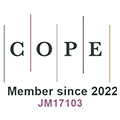REFERENCES
1. Thayabaranathan, T.; Kim, J.; Cadilhac, D. A.; et al. Global stroke statistics 2022. Int. J. Stroke. 2022, 17, 946-56.
2. Feigin, V. L.; Forouzanfar, M. H.; Krishnamurthi, R.; et al. Global and regional burden of stroke during 1990-2010: findings from the Global Burden of Disease Study 2010. Lancet 2014, 383, 245-54.
3. Peng, L.; Hou, Z. G.; Peng, L.; Luo, L.; Wang, W. Robot assisted rehabilitation of the arm after stroke: prototype design and clinical evaluation. Sci. China. Inf. Sci. 2017, 60, 073201.
4. Bütefisch, C.; Hummelsheim, H.; Denzler, P.; Mauritz, K. H. Repetitive training of isolated movements improves the outcome of motor rehabilitation of the centrally paretic hand. J. Neurol. Sci. 1995, 130, 59.
5. Lum, P. S.; Burgar, C. G.; Shor, P. C.; Majmundar, M.; Van der Loos, M. Robot-assisted movement training compared with conventional therapy techniques for the rehabilitation of upper-limb motor function after stroke. Arch. Phys. Med. Rehabil. 2002, 83, 952-9.
6. Norouzi-Gheidari, N.; Archambault, P. S.; Fung, J. Effects of robot-assisted therapy on stroke rehabilitation in upper limbs: systematic review and meta-analysis of the literature. J. Rehabil. Res. Dev. 2012, 49, 479-96.
7. Sankar, K.; Muthukumar, S. D.; Kannan, P.; Mariappan, S.; Kalidoss, S. Robot-assisted therapies for upper limb stroke rehabilitation: a narrative review. 2024 International Conference on Cognitive Robotics and Intelligent Systems (ICC - ROBINS), Coimbatore, India. Apr 17-19, 2024. IEEE, 2024; pp. 750-6.
8. Li, G.; Fang, Q.; Xu, T.; Zhao, J.; Cai, H.; Zhu, Y. Inverse kinematic analysis and trajectory planning of a modular upper limb rehabilitation exoskeleton. Technol. Health. Care. 2019, 27, 123-32.
9. Flash, T.; Meirovitch, Y.; Barliya, A. Models of human movement: trajectory planning and inverse kinematics studies. Robot. Auton. Syst. 2013, 61, 330-9.
10. Wang, C.; Peng, L.; Hou, Z. G.; et al. Kinematic redundancy analysis during goal-directed motion for trajectory planning of an upper-limb exoskeleton robot. In: 2019 41st Annual International Conference of the IEEE Engineering in Medicine and Biology Society (EMBC), Berlin, Germany. Jul 23-27, 2019. IEEE, 2019; pp. 5251-5.
11. Kim, H.; Miller, L. M.; Byl, N.; Abrams, G. M.; Rosen, J. Redundancy resolution of the human arm and an upper limb exoskeleton. IEEE. Trans. Biomed. Eng. 2012, 59, 1770-9.
12. Secco, E. L.; Visioli, A.; Magenes, G. Minimum jerk motion planning for a prosthetic finger. J. Robot. Syst. 2004, 21, 361-8.
13. Ghobadi, M.; Sosnoff, J.; Kesavadas, T.; Esfahani, E. T. Using mini minimum jerk model for human activity classification in home-based monitoring. In: 2015 IEEE International Conference on Rehabilitation Robotics (ICORR), Singapore. Aug 11-14, 2015. IEEE, 2015. pp. 909–12.
14. Zadravec, M.; Matjačić, Z. Development of optimization-based simulation tool for trajectory planning in planar arm reaching after stroke. In: 2012 4th IEEE RAS & EMBS International Conference on Biomedical Robotics and Biomechatronics (BioRob), Rome, Italy. Jun 24-27, 2012. IEEE, 2012. pp. 1446–50.
15. Zadravec, M.; Matjačić, Z. Planar arm movement trajectory formation: An optimization based simulation study. Biocybern. Biomed. 2013, 33, 106-17.
16. Friedman, J.; Flash, T. Trajectory of the index finger during grasping. Exp. Brain. Res. 2009, 196, 497-509.
17. Averta, G.; Della Santina, C.; Valenza, G.; Bicchi, A.; Bianchi, M. Exploiting upper-limb functional principal components for human-like motion generation of anthropomorphic robots. J. Neuroeng. Rehabil. 2020, 17, 63.
18. Li, Z.; Zuo, W.; Li, S. Zeroing dynamics method for motion control of industrial upper-limb exoskeleton system with minimal potential energy modulation. Measurement 2020, 163, 107964.
19. Huang, Y.; Jia, L.; Chen, J.; Zheng, J.; Guo, Y.; Tao, Y. A novel path planning algorithm considering the maximum deflection angle of joint. IEEE. Access. 2021, 9, 115777-87.
20. Wang, C.; Peng, L.; Hou, Z. G. A control framework for adaptation of training task and robotic assistance for promoting motor learning with an upper limb rehabilitation robot. IEEE. Trans. Syst. Man. Cybern. Syst. 2022, 52, 7737-47.
21. Chakravorty, S.; Kumar, S. Generalized sampling based motion planners with application to nonholonomic systems. In: 2009 IEEE International Conference on Systems, Man and Cybernetics, San Antonio, USA. Oct 11-14, 2009. IEEE, 2009. pp. 4077-82.
22. Bakaev, V. S.; Goloburdin, N. V.; Kulagin, K. A.; Anisimov, R. O. Trajectory planning of a manipulator robot in joints space. In: 2022 International Conference on Information, Control, and Communication Technologies (ICCT), Astrakhan, Russian Federation. Oct 03-07, 2022. IEEE, 2022. pp. 1-5.
23. Sabbaghi, E.; Bahrami, M.; Ghidary, S. S. Learning of gestures by imitation using a monocular vision system on a humanoid robot. In: 2014 Second RSI/ISM International Conference on Robotics and Mechatronics (ICRoM), Tehran, Iran. Oct 15-17, 2014. IEEE, 2014; pp. 588-94.
24. Tang, S.; Chen, L.; Barsotti, M.; et al. Kinematic synergy of multi-DoF movement in upper limb and its application for rehabilitation exoskeleton motion planning. Front. Neurorobot. 2019, 13, 99.
25. Shahbazi, H.; Parandeh, R.; Jamshidi, K. Implementation of imitation learning using natural learner central pattern generator neural networks. Neural. Netw. 2016, 83, 94-108.
26. Lauretti, C.; Cordella, F.; Ciancio, A. L.; et al. Learning by demonstration for motion planning of upper-limb exoskeletons. Front. Neurorobot. 2018, 12, 5.
27. Nguiadem, C.; Raison, M.; Achiche, S. Motion planning of upper-limb exoskeleton robots: a review. Appl. Sci. 2020, 10, 7626.
28. Wu, Q.; Wang, X.; Chen, B.; Wu, H. Development of a minimal-intervention-based admittance control strategy for upper extremity rehabilitation exoskeleton. IEEE. Trans. Syst. Man. Cybern. Syst. 2018, 48, 1005-16.
29. Li, X.; Yang, Q.; Song, R. Performance-based hybrid control of a cable-driven upper-limb rehabilitation robot. IEEE. Trans. Biomed. Eng. 2021, 68, 1351-9.
30. Zhang, M.; Wang, C.; Zhang, C.; Li, P.; Liu, L. A unified switching control framework for continuous robot-assisted training. IEEE/ASME. Trans. Mechatron. 2024, 29, 2743-55.
31. Wu, J.; Huang, J.; Wang, Y.; Xing, K.; Xu, Q. Fuzzy PID control of a wearable rehabilitation robotic hand driven by pneumatic muscles. In: 2009 International Symposium on Micro-NanoMechatronics and Human Science, Nagoya, Japan. Nov 09-11, 2009. IEEE, 2009; pp. 408-13.
32. Proietti, T.; Jarrassé, N.; Roby-Brami, A.; Morel, G. Adaptive control of a robotic exoskeleton for neurorehabilitation. In: 2015 7th International IEEE/EMBS Conference on Neural Engineering (NER), Montpellier, France. Apr 22-24, 2015. IEEE, 2015; pp. 803-6.
33. Koshkouei, A. J.; Zinober, A. S. I. Terminal sliding mode control of MIMO linear systems. In: Proceedings of the 2002 American Control Conference (IEEE Cat. No. CH37301), Anchorage, USA. May 08-10, 2022. IEEE, 2002; pp. 2106-11.
34. Feng, Y.; Yu, X.; Han, F. On nonsingular terminal sliding-mode control of nonlinear systems. Automatica 2013, 49, 1715-22.
35. Zou, A. M.; Kumar, K. D.; Hou, Z. G.; Liu, X. Finite-time attitude tracking control for spacecraft using terminal sliding mode and Chebyshev neural network. IEEE. Trans. Syst. Man. Cyber. B. 2011, 41, 950-63.
36. Kim, K. S.; Park, Y.; Oh, S. H. Designing robust sliding hyperplanes for parametric uncertain systems: a Riccati approach. Automatica 2000, 36, 1041-8.
37. Choi, H. H. LMI-based sliding surface design for integral sliding mode control of mismatched uncertain systems. IEEE. Trans. Autom. Control. 2007, 52, 736-42.
38. Wen, C. C.; Cheng, C. C. Design of sliding surface for mismatched uncertain systems to achieve asymptotical stability. J. Frankl. Inst. 2008, 345, 926-41.
39. Utkin, V.; Shi, J. Integral sliding mode in systems operating under uncertainty conditions. In: Proceedings of 35th IEEE Conference on Decision and Control, Kobe, Japan. Dec 13, 1996. IEEE, 1996; pp. 4591-6.
40. Wei, X.; Zhang, H.; Guo, L. Composite disturbance-observer-based control and terminal sliding mode control for uncertain structural systems. Int. J. Syst. Sci. 2009, 40, 1009-17.
41. Man, Z.; Xing, H. Y. Terminal sliding mode control of MIMO linear systemst. IEEE. Trans. Circuits. Syst. I. Fundam. Theory. Appl. 1997, 44, 1065-70.
42. Wang, C.; Zhang, Y.; Peng, L; Zou, A. M.; Hou, Z. G. Dynamic modelling and adaptive control of an upper-limb robotic exoskeleton. In: 2024 IEEE International Conference on Advanced Information, Mechanical Engineering, Robotics and Automation (AIMERA), Wulumuqi, China. May 18-19, 2024. IEEE, 2024; pp. 249-54.
43. Hogan, N. An organizing principle for a class of voluntary movements. J. Neurosci. 1984, 4, 2745-54.
44. Yang, X. R.; Lin, X.; Yang, Y.; Zou, A. M. Finite-time attitude tracking control of rigid spacecraft with multiple constraints. IEEE. Trans. Aerosp. Electron. Syst. 2024, 60, 3688-97.
45. Kang, H. B.; Wang, J. H. Adaptive control of 5 DOF upper-limb exoskeleton robot with improved safety. ISA. Trans. 2013, 52, 844-52.
46. Yu, S.; Yu, X.; Shirinzadeh, B.; Man, Z. Continuous finite-time control for robotic manipulators with terminal sliding mode. Automatica 2005, 41, 1957-64.









